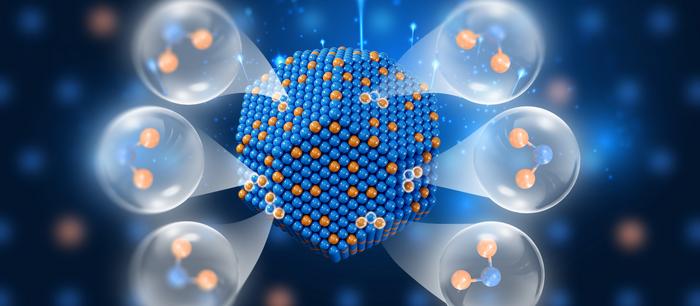
A groundbreaking achievement in the field of catalysis has emerged from a collaborative study led by Professors SHEN Wenjie and LI Yong from the Dalian Institute of Chemical Physics, under the auspices of the Chinese Academy of Sciences. Their research has unveiled a new methodology for precisely tuning the active sites of bimetallic catalysts at the atomic level. This innovative approach addresses the long-standing challenge of enhancing both the activity and selectivity in catalyzing chemical reactions, particularly notable in hydrogenation processes.
Bimetallic catalysts, which consist of both a noble metal and a base metal, are recognized for their exceptional catalytic efficiency, especially in selective hydrogenation reactions. The unique catalytic properties of these particles arise from their varied electronic and geometric structures. When it comes to molecular interactions, achieving the desired level of selectivity during hydrogenation necessitates precise site-specific interactions. Such interactions allow the active atoms within the catalyst to selectively interact with the functional groups present in the reactants. This selectivity is key to enhancing reaction efficiency and product yields.
To explore this concept further, the researchers found that reducing bimetallic particles to nanoscale atomic clusters significantly improves the surface dispersion of the noble metal atoms. This increase in surface area directly correlates with a heightened utilization of these valuable noble metal resources. Furthermore, nanoscale dimensions alter the electronic properties of the catalyst, leading to modifications in the intrinsic catalytic activity. With meticulous tuning of bonding structures, the electronic properties of single noble metal atoms bonded to their base metal counterparts can be optimized. Such precision allows for flexible accommodation of reactants and fosters an environment conducive to activating specific functional groups.
Despite its promise, achieving atomic precision in the fabrication of these active sites has proven to be a formidable challenge. However, the latest work spearheaded by the team from Dalian Institute of Chemical Physics marks a significant step forward in this area. Their study, recently published in the esteemed journal Chem, presents a method that not only successfully regulates the atomic structure of the catalyst active sites but also demonstrates a clear advancement in hydrogenation selectivity.
The researchers devised a novel technique that enables the dense population and exact positioning of isolated platinum (Pt) atoms in the form of Pt-Fe-Pt heterotrimers on α-Fe nanoparticles. This heterotrimer structure was synthesized through an innovative hydrogen (H2) reduction process involving a precursor of a Pt-Fe2O3 particle pair. By reducing iron oxides to iron, the researchers facilitated the dispersion of Pt atoms into the desired trimer form. The resulting Pt-Fe-Pt structure plays a pivotal role in enhancing the catalytic activity of the iron nanoparticle platform.
Within the context of hydrogenation reactions, particularly involving crotonaldehyde, the newly developed Pt-Fe-Pt heterotrimer displayed a remarkable preference for hydrogenating the carbon-oxygen (C=O) bond. This selectivity effectively led to the production of crotyl alcohol over the more typically unsaturated carbon-carbon (C=C) bond transformation. The researchers’ findings indicate a staggering 35-fold increase in the intrinsic hydrogenation rate associated with this reaction, directly addressing the prevalent activity-selectivity trade-off that conventionally plagues bimetallic catalysts.
Moreover, the team employed advanced characterization techniques to elucidate the formation pathway and coordination environment surrounding the Pt-Fe-Pt heterotrimers. They identified a distinct site-bond recognition pattern, wherein the left-end Pt atom was shown to anchor the C=C bond, while concurrently, the central Fe atom activated the C=O bond. This strategic arrangement allowed for efficient hydrogenation through additional H atoms, which were adsorbed onto the right-end Pt atom. Such detailed molecular understanding could lead to further optimization of catalytic processes in industrial applications.
The implications of this research extend well beyond fundamental science. With the ability to tailor active sites on bimetallic catalysts with atomic precision, the potential for practical applications in chemical manufacturing and pharmaceuticals is substantial. By improving selectivity and efficiency in hydrogenation processes, industries can expect enhanced yield outcomes, reduced costs, and minimized environmental impacts, aligning with the global push towards sustainable practices.
Professors SHEN and LI express optimism about the future of catalytic science, emphasizing that their work quantifies catalytic surface reactions at a molecular level. This foundational understanding paves the way for the next generation of catalysts with highly customized properties aimed at tackling complex chemical challenges. As researchers continue to unlock the secrets behind bimetallic catalysts, we may soon witness innovative solutions in fields ranging from renewable energy to fine chemical synthesis.
Importantly, the findings and methodologies presented in their study could spark significant advancements in the realms of catalysis research and application. As more scientists delve into the potential of atomic precision in designing catalytic systems, the horizon of what is achievable in chemical transformations expands exponentially.
In conclusion, the integration of atomic precision in the development of bimetallic catalysts represents a pivotal leap forward in chemistry. The work conducted by the team from Dalian Institute of Chemical Physics sets a new standard for catalyst development and offers a framework for future studies to build upon. With the catalytic landscape ever-changing, the steadfast pursuit of innovation will undoubtedly yield remarkable breakthroughs in the coming years.
Subject of Research: The research focuses on the atomic precision tuning of bimetallic catalyst active sites for enhanced selective hydrogenation processes.
Article Title: Fine-tuned coordination environment of Pt-Fe-Pt active site for selective heterogeneous hydrogenation of crotonaldehyde.
News Publication Date: 3-Jan-2025.
Web References: DOI link, Dalian Institute of Chemical Physics
References: Not applicable.
Image Credits: Credit: DICP.
Keywords
Hydrogenation, Catalysis, Bimetallic catalysts, Active sites, Molecular interactions, Selective reactions, Electronic structure, Surface alloying, Chemical transformations, Sustainable practices.





